





What most call flowers on Euphorbia species are a bit more complex than that. And though the Euphorbia's actual flowers are somewhat dinky and similar, the cyathia which they are part of can be quite diverse, amazing and ornamental structures. This article is a basic introduction to these weird flower-like structures.
When I recently was telling someone about one of my Euphorbia flowering, they pointed out to me that Euphorbia have cyathia, not flowers, so they can't flower. Well, that was simply hard to believe so I looked into the details of Euphorbia ‘flowers' and discovered that indeed these are flowering plants and they do have flowers. But what we often call their flowers are really more complex structures that include their flowers and multiple other parts, the sum total which are referred to as cyathia (or singularly, cyathium). When this distinction usually arises is when one is asked to describe the color of their flowers (as one is asked to do any time one enters a plant into the Plantfiles of Davesgarden). Now I am unsure how to answer this question, as the flowers themselves are really small, and often a completely different color than the rest of the cyathia, the structure which most observers consider to be their flowers. And to make things even more difficult, most Euphorbias have both male and female flowers, and sometimes these are different colors. THEN what color do you say their flowers are?
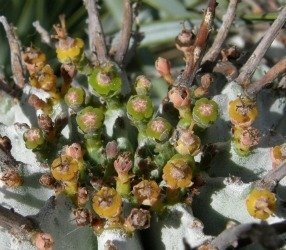
Euphorbia 'Wundulate' has green or yellow nectar glands, but the flower parts are peach to pink colored. So it would be correct to say this plant has peach colored flowers, but no one would understand unless they knew which parts were the actual flowers.
Anyway, after looking into these issues in a bit more depth, I discovered that many Euphorbia cyathia are sometimes beautiful and bizarre structures, often worth looking at close up (sadly I do not have a good macro lens). So this article will include a lot of Euphorbia photos taken by others that have far better photographic skills than myself. I have, however, also included some of my drawings for discussion sake, to clarify what parts are what, so we can finally all be on the same page when it comes to discussing Euphorbia ‘flowers', or cyathia.
The genus Euphorbia consists of over 2000 species, and the Euphorbia family has even more species in it. Though not all the other genera of plants in the Euphorbia family have cyathia, there are some similarities in their flower structures. The variety in the Euphorbia genus is amazing and this article will barely touch the surface of the possible Euphorbia floral structures that can be found in nature.
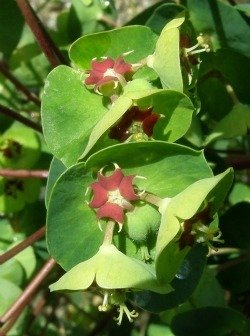
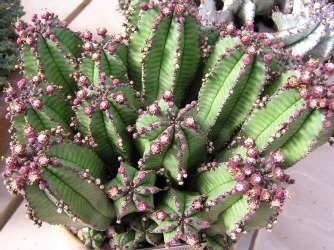
Euphorbia amygdaloides (left) Euphorbia anoplia (right)
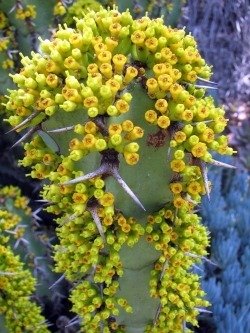
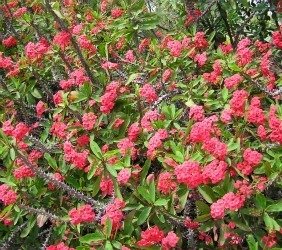
Euphorbia coerulescens (left) Euphoria milii (aka Crown of Thorns- right)
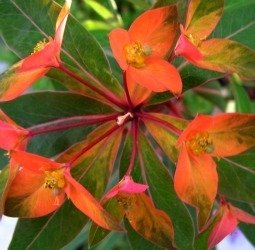
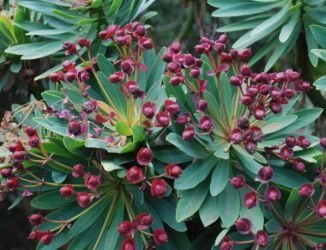
Euphorbia griffithi (left) Euphorbia atropurpurea (right)
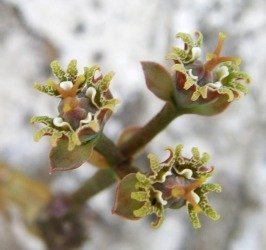

Euphorbia monteiri (left) Euphorbia verruculosa (right) showing female flowers
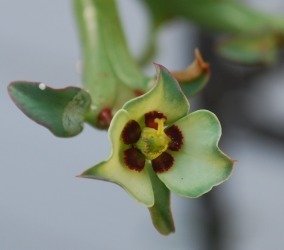
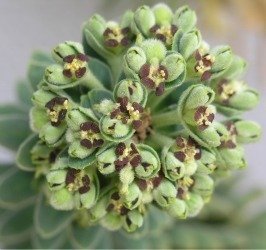
Euphorbia hamata cyathia with catophylls surrounding it (left); fuzzy cyathia on this Euphorbia Portuguese Velvet (right)
In Euphorbias, the flowers are only small appendages growing out of a larger structure called the involucre. This structure is basically the body of the cyathium which comes off the main plant on short stems called peduncles. Sometimes after the cythia fall off, these peduncles are retained giving the plant a spiny look. Sometimes multiple cyathia arise off a single peduncle in a group referred to as a cyme.
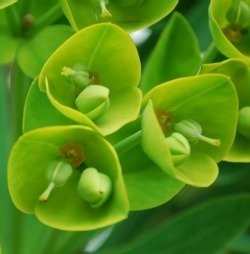
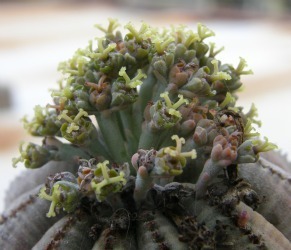
Euphorbia lambii showing female flowers coming out of from center of cyathia (left) ; Euphorbia obesa female plant showing femal flowers
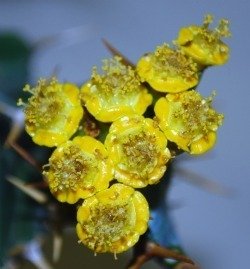
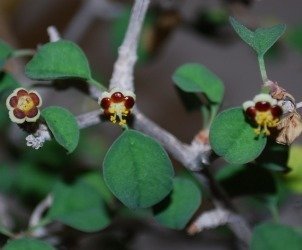
Euphorbia persistens with only male flowers (so far- left); Euphorbia misera with male flowers showing
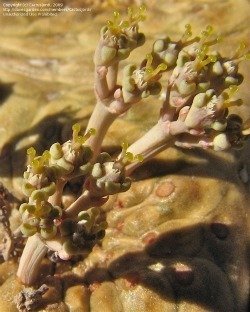
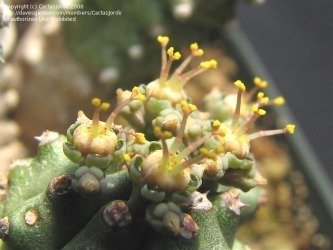
two incredible photos from CactusJordi, showing clearly the female flowers (left) on this Euphorbia turbiniformis; and in the right photo, the male flowers of Euphorbia mosaica
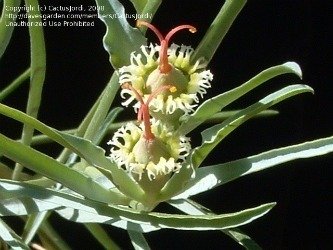
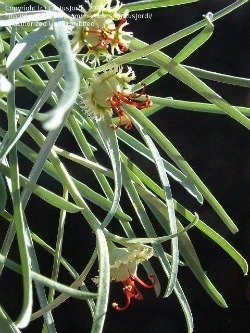
but in probably the best demonstration of all are these comparison photos (also by CactusJordi) showing the female flower of Euphorbia hallii on left and male on right (same plant, different stages of development, though I do not know which came first)
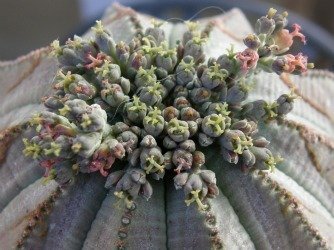
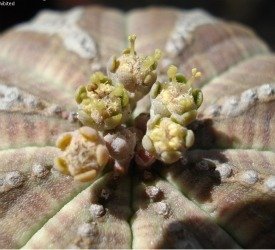
Euphorbia obesa is a species that is dioecious (separate male and female plants). The female is left and male right (right photo cactus_lover)
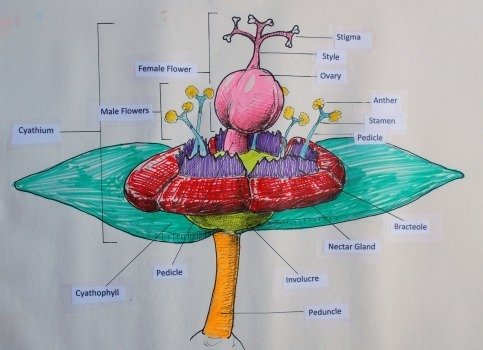
This is a 'stylized' rendition of a cyathia labeled showing the basic parts
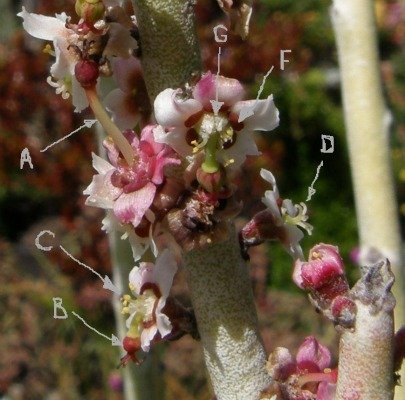
This photo of Euphorbia antisyphylitica has been labeled with a few floral palrts: A- pedicle of female flower; B- ovary of female flower; C- tips (stamen) of male flowers; D- tips (styles) of female flower; F- nectar gland in dark maroon; G- bracteoles nearly white
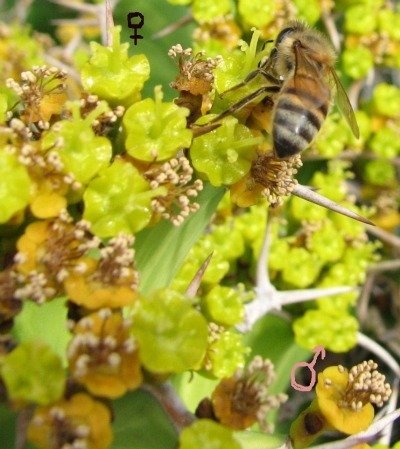
This bee is walking across a sea of cyathia belonging to Euphorbia pseudocactus with a few female flowers (coming out of the lime green cyathia) pointed out with a black female symbol and a few male flowers (on the older yellow cyathia) pointed out with a pink male symbol
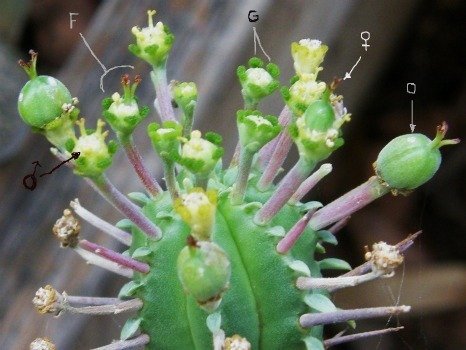
Euphorbia cumulata showing both male and female flowers: male and female flowers labeled with appropriate symbols; O= ovary; G= nectar glands; F= flowers of both sexes near each other
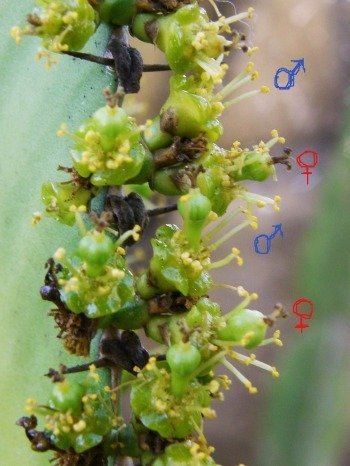
Last instructional photo: Euphorbia triangularis with male and female flowers labeled.
The involucres has at least one nectar gland arising from it as well. The most common number of glands seen in most species of Euphorbia are five, but some have just one (like in the Poinsettia, Euphorbia pulcherrima) and some have four. When more than one, the glands tend to be arranged symmetrically around the body of the involucres surrounding the other structures within (the flowers and bracteoles). These glands sometimes have ornate appendages that come off them creating pseudo-petals that surround the cyathium giving it wonderfully ornate and ornamental appearance (presumably to attract pollinators).
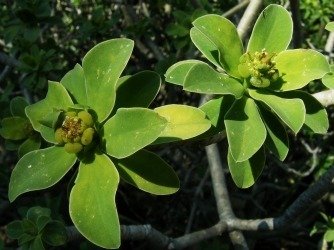
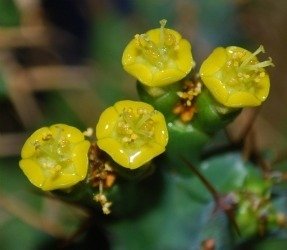
Both Euphorbias balsamifera (left) and clavigera (right) show the typical number of 5 nectar glands (light green in E balsamifera and bright yellow in E clavigera). Note the glands of Euphorbia clavigera are also moist (from the nectar produced by these glands).
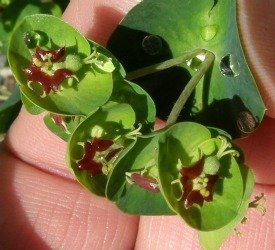
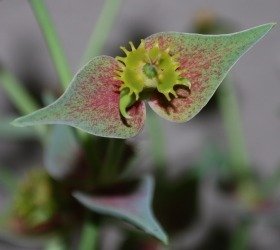
Euphorbia amygdaloides with four ornate glands (left); Euphorbia monteiri also with four very ornate glands (right)
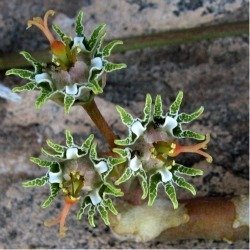
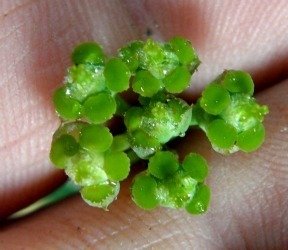
Euphorbia verruculosa showing four very complex glands and both male and female flowers (left); Euphorbia fasciata showing four offset glands and all cyathia have a space where it seems a fifth gland should be (right)
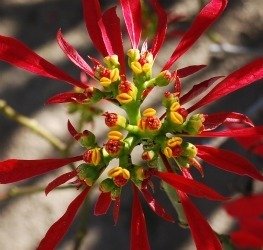
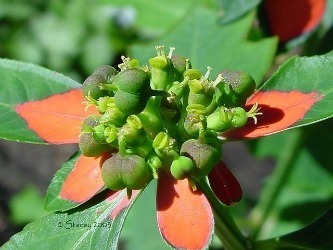
Euphorbia pulcherrima (aka Poinsettia- left photo) is one of the most commonly grown Euphorbias. Often the red brack-like leaves are assumed to be floral parts but they are only colored leaves. The cyathia in the center have single yellow-colored nectar glands, though some cyathia appear to have two glands each. The flower parts are indeed red but barely visible next to each yellow nectar gland. Closely related Euphorbia cyathophora (right) also has single nectar glands. One can also both male and female flowers in different stages in development in this photo (photo by Floridian)
Within the circle created by the glands are the bracteoles (miniature united bracts that almost always number five, though the associated number of male flowers runs anywhere from one to ten), which are sometimes the only structures seen as the cyathium matures. Then the bracteoles open up just like the petals of a flower, and the true floral parts emerge. Sometimes the first flowers to emerge are the male flowers, often symmetrically, but sometimes seemingly randomly surrounding the very center of the cyathium. These are simplified structures relative to what one sees in most other flowering plants and consist only of a single pedicle (which would be the filament on most flowers), which ends in a short stamen topped by a paired anther. Usually these structures are the same color as the glands, but not always. The anthers often are yellow colored and stand out strikingly if the rest of the structures are a red, green or purple coloration. These anthers contain the pollen of the Euphorbia (the male zygotes... or the plant equivalent of the sperm).
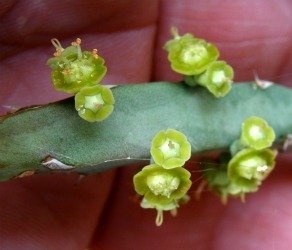
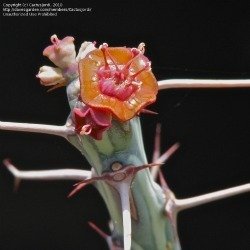
Euphorbia ambroseae showing male flowers emerging from the pale, almost white bracteoles (left); Euphorbia schizacantha in the male phase with dark red bracteoles within the orange nectar glands (right- photo by CactusJordi)
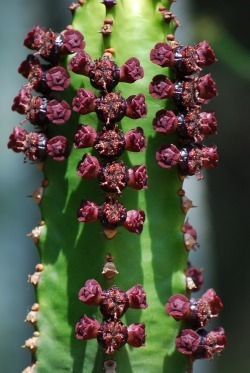
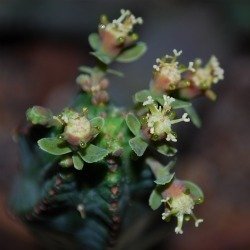
Euphorbia canariensis with rows of cyathia grouped in threes (forming a cyme), with only the center rows flowering (male flowers), while the outer rows of cyathia have pale maroon centers which are the bracteoles covering the flower parts underneath (left photo); Euphobia tubiglans showing male flowers in the cyathia (right)
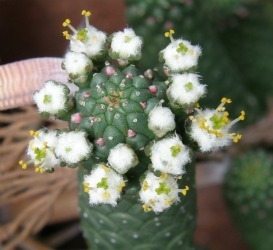
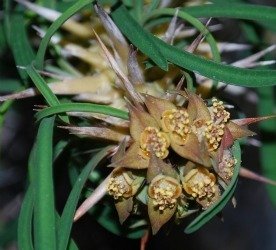
Euphorbia inermis showing a thick layer of white fuzz covering the bracteoles from which the male flowers are emerging (left); Euphorbia rossii showing male flowers in its cyathia (right)
The female flower will sometimes develops subsequently, often prior to the male flowers, and sometimes simultaneously with the male flowers. However, many Euphorbias only have one or the other sex of flower (these plants are called dioeciouis, but are the exception rather than the rule). There is only one female flower on each cyathium and it arises from the very center of the cyathium (this arrangement is rather similar to how it is in most flowering plants). It has a stalk called a pedicle, as on the male flowers, and an enlarged, three-chambered ovary (which later develops into the fruit, or seed pod). This ovary can be so large it pulls the female flower over and droops downward or to the side. The ovary has the styles coming out if it- this is always a three-pronged structure with three styles ending in a double-ended structure called the stigma which is the part of the flower that accepts the pollen.
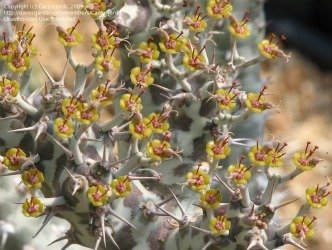
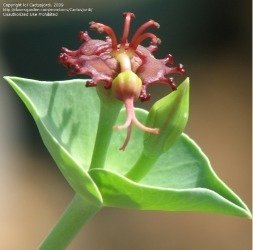
Euphorbia horwoodii showing cyathia with male flowers as a few female flowers begin to emerge (left); Euphorbia monteiri showing both male (3) and female (1) flowers (right- both photos by CactusJordi)
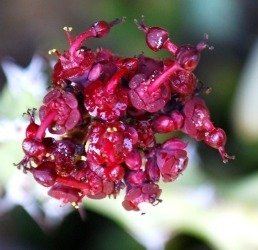
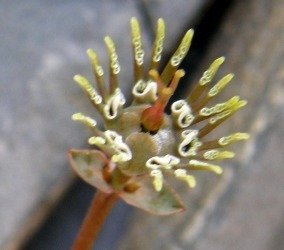
Euphorbia richardisae showing the twisted, emegent female flowers (left); Euphorbia verruculosa with the single female flower protruding from the overlapping bracteoles (right)
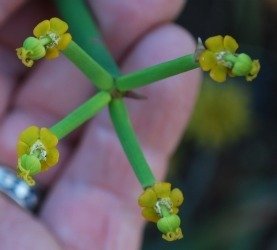
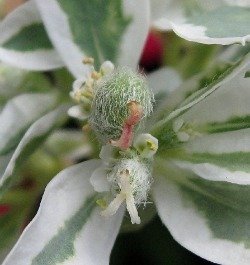
Euphorbia schimperi with female flowers emerging (left); Euphorbia marginata 'Kilimanjaro' with female flowers emerging from bulbous, fuzzy involucre (photo Kell)
The seed pod is always, as far as I can tell, a three-chambered structure. As the seeds develop within, its color may change or brighten, sometimes becoming quite striking (maybe to make an animal eat it and disperse the seed... or as a warning that it is toxic and NOT to eat it... hmmm). These seed pods often burst when mature and drying, sending the seeds flying many feet in all directions.
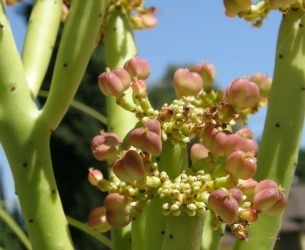
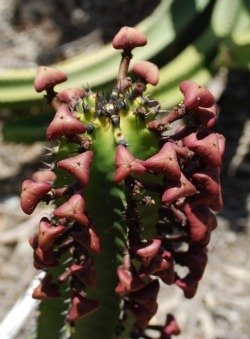
Euphorbias leucondendron (left) and canariensis (right) show progression of female ovaries to the seed pod stage
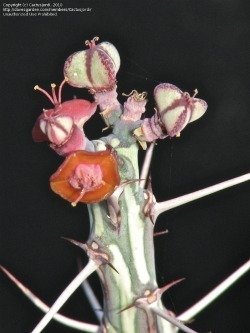
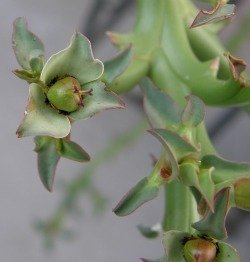
Euphorbia schizacantha (left) showing various stages of development on the same plant, with the final seed pod stage visible with the striking pale with red-striped seed pods (photo CactusJordi); left is Euphorbia hamata female ovaries having developed into small seed pods
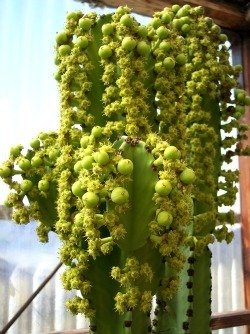
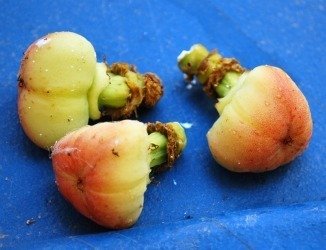
Euphorbia ingens flowering both male and female (left) with the female flowers developing into seed pods; right shows maturing seed pods of Euphorbia ingens
In some species of Euphorbia the entire involucre is sitting in the center of structures (usually paired but many times not) called cyathophylls. These are basically the Euphorbia's equivalent a true flower's bracts as they look a lot like the colored bracts seen on many other flowering plant species that have small insignificant central flowers and colorful bracts (as in Bougainvillea). The Euphorbia miliis are grown specifically for these marvelous, colorful bract-like structures.
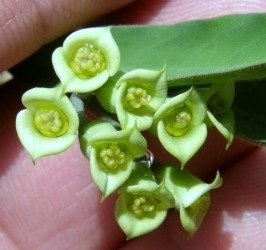
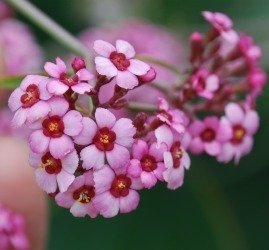
Euphorbia mahafalensis (left) with pale green cyathophylls; Euphorbia xanti (right) with bright pink cyathophylls
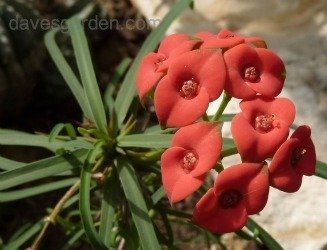
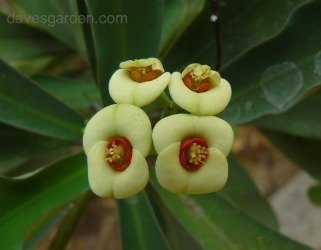
Euphorbia milii (Crown of Thorns or COTs as some refer to them as) come in a large variety of cyathophyll colors and sizes (photo left by Saya and right by Dinu)
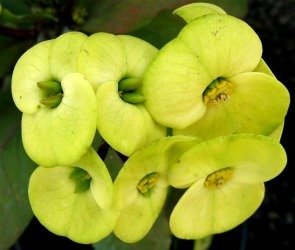
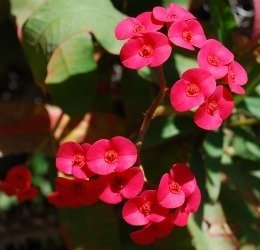
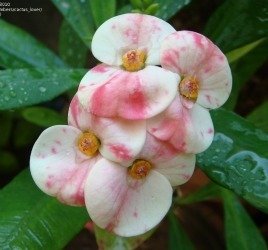
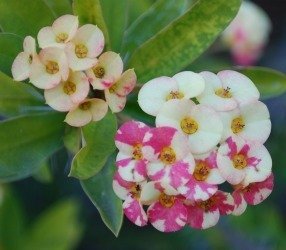
Euphorbia milii varieties showing various cyathophyll colorations (photo lower left cactus_lover)
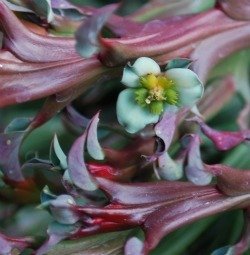
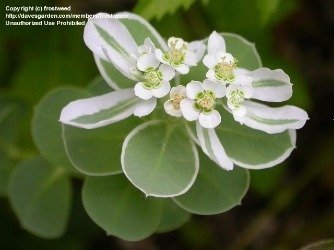
Euphorbia peltigera showing a nice turqoise set of cyathophylls (left); right Euphorbia marginata (photo frostweed) has white cyathophylls
On other species of Euphorbias, the cyathia are centered within colorful bract-like leaves (as in Poinsettias). These are true leaves, however.
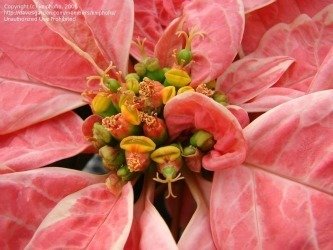
Euphorbia pulcherrima 'Freedom Marbel' named for the colorful bract-like leaves surrounding the cyathia on this ornamental Poinsettia (photo kniphofia)
So now when you see a Euphorbia maturing and developing these amazing structures, instead of saying it is flowering, you can tell others it is ‘cyathiazing'... well, maybe not. I just made up that word.
For more on Euphorbia cyathia see the following helpful links:
http://en.wikipedia.org/wiki/Cyathium
http://www.euphorbiaceae.org/pages/about_euphorbia.html
http://www.euphorbia.de/cyathien.htm
Copyright © www.100flowers.win Botanic Garden All Rights Reserved